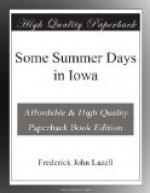Sumac flames from the fence corners and lights up the country lanes. It is the first of the shrubs to announce in fiery placards the coming spectacle of the passing of the summer. Next is the Virginia creeper,—see where it flames up the wild cherry tree, scattering crimson leaves to the grass beneath. Once in a day’s journey along the creek one may find a small red maple. In the middle of its foliage is a small, flame-like spot which grows larger day by day. Gradually some of the other maples catch the color fire, first a little soft maple by the shore of a muddy bayou, next a small sugar maple on the rocky slope. The great spectacle does not come until October, but the placards announcing it grow more numerous and vivid day by day. Blackberry leaves are splashed with crimson; daily the blood-red banner of the sumac grows larger and more striking. Walnuts and hickories begin to lose their yellow leaves; patches of yellow appear on the elms and the lindens; though the mass of the foliage remains until October, many leaves flutter down daily, and it is possible to see twice as far into the thicket as in June.
"The wine of life keeps
oozing, drop by drop;
The leaves of life keep falling,
one by one."
Flocks of grackles spend their days in the cornfields which run down to the creek bottom and their nights amid the wild rice and the rushes and willows in the swamp. In the timber fringes and the broad bottoms along the creek you get glimpses of the catbird feasting on the grapes and the wild plums; the brown thrasher and the woodthrush, wholly silent now; the little house wren who has lost her chatter; the vireos and the orioles, the wood pewee, the crested fly catcher and the kingbird. They all seem to be going southward. There are a few nests and young birds in the early part of the month—the yellow-billed cuckoo, the Savannah sparrow, the goldfinch. But these are exceptions to the general rule.
Little flocks of warblers flit among the tree tops and the bushy margin of ponds near the creek will soon be alive with the myrtle warblers—as numerous as English sparrows in a barn-yard. In the night time you may hear the “tseep” of the warblers as they wing their way swiftly towards the southland. Sometimes there is the tinkling sound of the bob-o-link, also flying in the night time, and in the morning there may be a flock of them in some meadow, leisurely getting their breakfast after their all-night flight, chattering to each other in the tinkling tones which are unlike any other song-talk in bird land.
The humming bird, the swallows, the purple martins, the chimney swifts, also seem to be a-pilgriming. Gradually you become conscious that all of them are flying southward, always down the stream and never up. The first keen blasts up in the northland have given them a warning and they are going steadily, happily, but for the most part silently, on down the stream, giving rare beauty to these halcyon days of




